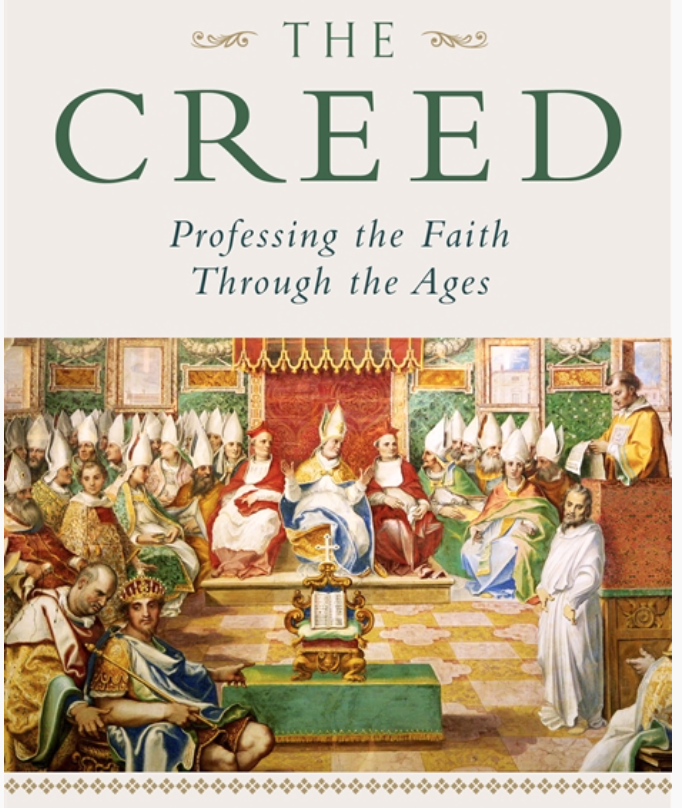Until the fairly recent new translation of the Creed for use in the Mass probably many Catholics recited it every Sunday as part of their normal routine without pausing a great deal to reflect on its content.
Scott Hahn’s new book, published just this week, provides many good reasons why we should all appreciate to a greater degree the Creed’s contents. “The Creed: Professing the Faith Through the Ages,” (Emmaus Road), explains its origins, content and applications for our daily lives.
At its most essential the Creed is an authoritative summary of a Christian’s key beliefs. It is a profession of our faith in mysteries, Hahn explained, that is, doctrines that have been revealed to us by God, things that we could never have known just through the use of our reason.
The Creed, however, is something that points us to something greater. We do not believe in formulas, but in the realities expressed by those formulas, Hahn noted, quoting the Catechism. The object of our faith is not a proposition, but a person – God.
“A creed is a symbol of something larger – and, ultimately, of Someone we love, Someone who makes us who we are, by means of creeds and other graces,” Hahn continued.
In terms of the historical development of the Creed Hahn explained that in the New Testament we find various summaries of Christ’s life and teachings. St Paul in his letter to the Romans spoke of a public confession of faith in Christ.
Public confession of faith
“Paul assumes that a true Christian statement of faith will acknowledge doctrines that set Christianity apart from every other religion: Jesus’ divinity, his identity as Messiah, and his Resurrection. He also specifies that a Christian confession should be made aloud,” Hahn noted.
Early on in the liturgy of the Church there was a question and answer type of creed, still used today at Baptism and during the Easter Vigil.
In the Sunday missal we normally find both the Nicene Creed and the shorter Apostles’ Creed. The Nicene Creed has been recited during Sunday mass for around a thousand years, but had its origins much earlier, initially in 325 at the Council of Nicea and then in more detail in 381 during the first Council of Constantinople.
The professions of faith that went on to be more formally defined in the text of the Nicene Creed were a confession of what Christians believed in and were to a great extent a response to persecution from without the Church and division from within.
The first centuries of Christianity were marked by multiple heresies regarding goodness of creation and material things, the nature of Christ, the role of the Holy Spirit and the nature of the Trinity.
As well as the need to defend key doctrines against heretical ideas Hahn explained that in the second and third centuries there was a movement towards a greater standardization of the Church’s life and liturgy.
In addition to considering the nature and historical development of the professions of faith Hahn also looked at some of the content and its implications for Christians. In the Creed, he said, we find both statements about the nature of God and statements about the works of God.
Thus, we find out about God being a Trinity, being eternal and our creator. In addition to declarations about the Son and the Holy Spirit we also encounter affirmations regarding the Church and its sacraments and our judgment.
Becoming godlike
A key element in Hahn’s book is its application to a Christian’s life as a believer. Professing belief in the Creed is far from being some merely formal or academic exercise.
“We become more godlike as we strive to imitate God’s human life. That is why we rehearse a brief summary of that life whenever we recite the creed,” he said.
That summary, Hahn observed, goes straight from Jesus’ birth to his Passion. It might seem strange to skip over all the details of his public life, but by focusing on his suffering we not only face the nucleus of why Jesus became man we also learn how to suffer as he did and to find the salvific dimension of suffering.
While we most probably won’t be called upon to perform miracles all of us will experience suffering and death, Hahn commented.
In his concluding chapter Hahn observed that our times are not that different from those of the early Church. Like then we encounter a wide diversity of opinions about Jesus and the content of what we are urged to believe in.
In such a situation Hahn recommends that “We should go forward, fortified by the creed.”
Creeds may well have become unfashionable, he admitted, yet they provide not only an antidote to modern skepticism and cynicism but also a vision to guide the way we live our lives.
The creeds are the rule and measure of true faith. Hahn declared, and with every recitation of the creed the Church is strengthened and renewed.



